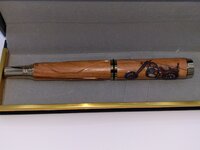donstephan
Member
Are older thicknessess of commercial veneer, 1/'32" or 1/16" a good or bad thickness for incorporating in pen blanks, perhaps by cutting a blank on the bias and inserting a thickness of veneer, or 3 thicknesses of contrasting veneer? A few days ago I was given a few pieces of veneer, some of which are much thicker than the commercial veneer I have purchased in the past for tabletops and such.

